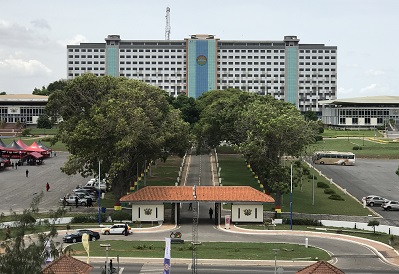Ghana’s preparedness for earthquake :Auditing of public buildings set to begin…Osu Castle, Jubilee, Parliament Houses, others included

The Engineering Council (EC) is gearing up to begin a structural audit of all public buildings and structures in the country, including the Christiansborg Castle (Osu castle) and Jubilee House; the former and current seats of government.
Other edifices earmarked for the exercise aimed at checking their capability to withstand earthquakes include Parliament house, courts, national theatre, office blocks of ministries, departments and agencies, stadia, hospitals, and markets.
Interchanges like the Kwame Nkrumah, Ako Adjei, footbridges, and national installations including Akosombo and Bui dams are part of the many structures to be assessed as part of the exercise to be piloted in Greater Accra Region.
The Council’s Right to Information Officer, Iddrisu Abdul Karim, who disclosed this to the Ghanaian Times in an exclusive interview in Accra on Thursday said the EC was waiting for the green light from the government to hit the ground running.
The audit is in compliance with a directive given by President Nana Akufo-Addo, in April this year to the Ministry of Works and Housing as part of efforts to build the country’s resilience to earthquakes of higher magnitude.
At a stakeholder conference held in Accra to deliberate on a committee report on the country’s earthquake preparedness and response, he said although earthquakes in themselves did not kill, the collapse of structures could cause human and economic losses.
Mr Karim said the Council was commissioned by the sector ministry following which the EC presented a proposal, about three months ago, detailing the nitty-gritty of the exercise.
“We were looking at the third to the fourth quarter of the year but we are now waiting for the green light to start work,” he said.
Mr Karim said a team of about 20 experts including geological engineers, earthquake engineers, seismologists, geophysics experts, architects, structural engineers, and other experts from the Council; Engineering Department of the Kwame Nkrumah University of Science and Technology and Architecture and Engineering Services Limited, had been put together for the exercise.
Other members of the team are from institutions like Council for Scientific and Industrial Research; Ghana Statistical Service; Ghana Institution of Engineering; Institution of Engineering and Technology; National Disaster Management Organisation(NADMO); district Assembles and some MDAs.
The structural audit, he said, would involve the measurement of the integrity and strength of concrete in the buildings and structures; the checking of ground, building frequencies as and reinforced steel used as rods in concrete.
If the government gives the go-ahead for the audit to begin, Mr Karim, said the pilot in the Greater Accra Region would take four months to complete; three months for fieldwork, and a month for data analysis.
“We are starting with Greater Accra because that is the centre of the earth tremor. It is mostly the coastal areas that experience it,” he said.
The RTI officer said owners of private buildings would be encouraged, after the entire exercise, to get their buildings checked as well. He declined to mention the budget for the national audit except to say it would be capital intensive.
Background
Ghana has a major active fault line for earthquake, stretching from the McCarthy Hill area in Accra westwards towards Kasoa-Nyanyanu in the Central Region and eastwards towards the Akuapem Ridge all the way to the Volta Region.
The NADMO has indicated that critical infrastructure such as Tema harbor, the Kotoka International Airport, Akosombo Dam and Weija Dam, and Jubilee House are on the fault tine.
According to Research Gate papers published by Ghanaian experts, Ghana has records of damaging earthquakes dating as far back as 1615 with the last three major events occurring in 1862, 1906, and 1939.
The 1939 earthquake was the severest with a local magnitude of 6.5 on the Richter scale, resulting in the death of 17 people and causing significant damage to property in Accra.
Since then, there have been reported occurrences of earthquakes, with the recent one occurring last year June which the Ghana Geological Survey Authority (GGSA) described as a signal of an imminent earthquake of greater magnitude.
BY JONATHAN DONKOR







